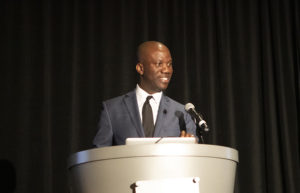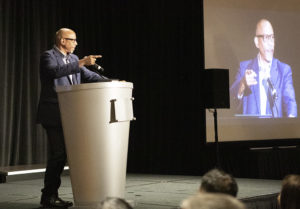More than 500 educators, community leaders, students and others gathered Thursday to discuss how to better support at-risk men and boys, especially Latino and black youth.
The “Know My Name Face and Story: Saving Our Most Vulnerable Youth” conference brought together experts from throughout the region to promote a conversation about how to address issues facing these student groups, and more importantly, what resources are available, or can be created to help these students succeed.
“The subject we are going to address today, I consider it to be the most critical problem facing public education,” Orange County Superintendent of Schools Dr. Al Mijares told the audience. “Obviously we need your help.”

The daylong forum, hosted by the Orange County Department of Education, featured research and insight from renowned academic experts followed by in-depth breakout sessions designed to promote equity, access and opportunity for all students. Speakers included Pedro Noguera, Ph.D., founder for the Center for the Transformation of Schools at UCLA; Shaun Harper, Ph.D., professor and executive director of the Race and Equity Center at USC; and Victor Rios, Ph.D., professor of sociology at UC Santa Barbara.
Harper told the audience that it’s now time to change the narrative that black youth are more likely than peers not to attend college, dropout of school and become incarcerated. Instead, Harper said, we should focus on the success stories of black youth, and what’s working to provide them more opportunities. Shifting this way of thinking will encourage a growth mindset by more proactively meet the needs of this population, Harper said.
Harper stressed how racial equity work should be led by people from all races, not just by people of color, and how mentors for at-risk students should also come from across the racial spectrum.

Noguera talked about how interventions for boys of color often focus on punitive practices (suspensions, expulsions, etc.), instead of interventions that look to find the root causes of the negative behavior.
“Who do we punish the most in our schools? Almost always those with the greatest needs,” he said. “All we need to do is look at their background and see the victimization they experience.”
Noguera offered some examples of what schools can do to more proactively support at-risk students. They include diverting high quality teachers to work with students who need the most help, he said. Many times, a school’s best teachers work only with the highest achieving students.
He added that building other support systems that improve health and safety, creating partnerships with colleges and universities and starting academic intervention at earlier ages are also necessary.
OCDE has long prioritized educating the whole child in inclusive learning environments that promote excellence, equity and access. In 2016, the department was tapped by the state to help school systems implement the California Multi-Tiered System of Support framework, which aligns new and existing strategies to meet students’ academic, behavioral and social-emotional needs.
